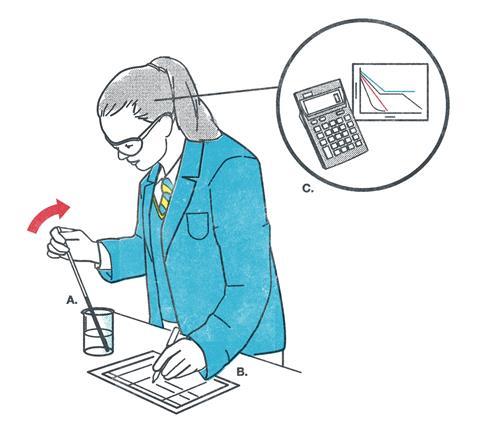Understand the importance of data and how your students need to learn how to collect, interpret and present it

Data is information. And every day we leave a trail of data that is collected and used in everything from medical image analysis and drug development to e-commerce and gaming. It’s a crucial part of modern day life.
In the science classroom, it’s no different. Data is just as important. Students need to understand data, its handling and presentation.
When students are doing practical work, they make observations, take readings, present data and do calculations. They’re using numbers in a real scientific context and this data has a meaning. Sometimes learners find it harder to interpret data in this context than they do in say their maths lessons. They can find the uncertainty of random and systematic errors difficult. We need to ensure they can appreciate the validity and limitations of data in science, considering its source and the collection method.
Download this
Maths skills worksheets, for age range 14–16
Use these classroom activities to target the key maths skills your students need for their science courses: rsc.li/3IKEL0A
Collecting, processing and presenting data
Collecting data forms the basis of early secondary school science experiments. Questions are asked within the classroom that can only be answered experimentally or empirically by collecting data, continually questioning its repeatability, reproducibility, accuracy and precision. There is a lot to think about.
Science students are familiar with the use of data and how it is used to answer scientific questions. However, if the data is not reliable, it might not be able to answer those questions. We need to show learners how to handle, manipulate and present data as well as helping them to understand that data can be misused and misinterpreted. This ability to think critically is an inherent part of what we do in science lessons.
Processing data often involves students carrying out various calculations in order to make the data more useful. For example, when students do their first titration, as well as having the practical skills and confidence to be able to handle some highly accurate apparatus, like a burette and a pipette, they must also know how to process and understand the titre readings from the burette. Scaffolding the many steps students need to deal with in a sequence of calculations can be helpful.
The use of significant figures and decimal places introduces students to uncertainty when using experimental data. A calculator quoting 11 significant figures as an answer may be considered to be beyond the level of accuracy offered by the experimental method.
Presenting data is a key way of showing the results of an experiment in a clear and concise manner. Students need to learn how to do this effectively, for example understanding that graphs are not simply pictures and being able to determine whether a bar chart or a graph isppropriate.
Recommended reading and resources
- Learn how to boost data skills using on-screen simulations.
- Try these activities to identify your students’ mathematical misconceptions when presenting chemistry data.
- Practise data handling and interpretation using your local air pollution levels with this resource from our Sustainability in Chemistry collection.
- Show students how laboratory analyst Joseph uses data to ensure drinking water is safe for millions of people.
- Learn how to boost data skills using on-screen simulations: rsc.li/3Ylfb85
- Try these activities to identify your students’ mathematical misconceptions when presenting chemistry data: rsc.li/3ZqenAj
- Practise data handling and interpretation using your local air pollution levels with this resource: rsc.li/3ISZwaz
- Show students how laboratory analyst Joseph uses data to ensure drinking water is safe for millions of people: rsc.li/XXXXXXX
Putting data into practice
To give students a broader understanding of the use of data, ask them to carry out some independent research to discover how data is used to inform everyday areas of life, for example healthcare or targeted advertising.
In science lessons, data collection, processing and presentation is integral to practical work. Giving students as many opportunities as possible to do experiments and then record, present and interpret data is an important part of their development as students and potential scientists.

This article is part of our Teaching science skills series, bringing together strategies and classroom activities to help your learners develop essential scientific skills, from literacy to risk assessment and more.










No comments yet